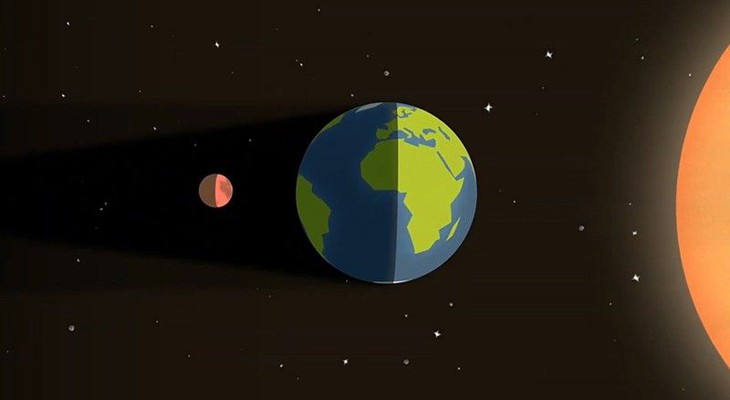
Illustration of a total lunar eclipse through the positions of the Moon - Earth - Sun - Photo: NASA
At that time, the Earth will be between the Sun and the Moon , our planet will block most of the sunlight from reaching the Moon, creating a total lunar eclipse. Unlike a solar eclipse which only lasts a few minutes, this total lunar eclipse will last about an hour. And we will be able to admire the phenomenon of Blood Moon when the Moon turns blood red.
According to IFLScience, this is due to Rayleigh scattering: when sunlight hits the Earth's atmosphere, the blue light in the spectrum is scattered more than the red light. The more light passes through the atmosphere, such as at sunrise and sunset, the more blue light is scattered, making the Sun appear more yellow or red.
During a lunar eclipse, the only light that reaches the Moon (apart from the light from the stars) is light that passes through Earth's atmosphere. Because blue light is more easily scattered while red light travels in a straighter path, the result is a moon bathed in a mysterious blood-red hue.
During a lunar eclipse, the more clouds or dust there are in Earth's atmosphere, the redder the moon will appear, "like all the sunrises and sunsets in the world are shining on the moon," according to NASA.
Unlike a solar eclipse, astronomy enthusiasts do not need specialized equipment to view a lunar eclipse, and can opt for binoculars or telescopes if they want a clearer view.
People in North and South America will be able to see the entire total lunar eclipse and Blood Moon display while people in some other regions will only be able to see part of it, according to the Guardian .
However, viewers in North America will have to stay up quite late if they want to see the entire process of the Moon being covered by darkness, at 11:26 p.m. PDT on March 13 and 2:26 a.m. EDT on March 14 (US time zones). According to NASA, this moment occurs at around 6:26 a.m. (UTC) on March 14 (ie 1:26 p.m. the same day Vietnam time).
People in Europe and Africa will only be able to see the first part of the eclipse before the Moon sets, while people in parts of Asia and Australia will be able to see the last part of the eclipse.
However, people in Europe, Africa, Asia and Australia will not have to wait too long to see the Blood Moon with the next total lunar eclipse occurring on September 7.
Source: https://tuoitre.vn/trang-mau-xuat-hien-toi-nay-13-3-20250312115835784.htm



































































































Comment (0)